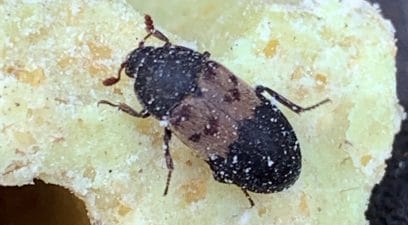Discover the Habitat and Life Cycle of the Larder Beetle.
These store product pests are not often seen, but what are Larder Beetles? Larder beetles are a type of beetle that is commonly found in homes, particularly in the kitchen and food storage areas. They are one of the families of hide beetles. The purpose of this blog is to introduce you to the ladder beetle. The reason for this is so if you ever come across one, you are able to identify it and the according action is taken place. They are easily identifiable so it should not be too difficult.
The Life Cycle of the Larder Beetle.
The four stages of the life cycle of a larder beetle are egg, larvae, pupa and adult. The complete cycle from egg to adult usually takes two to three months. A female will lay singly, in the region of 200 eggs on a food source over a six-month period. These eggs will then hatch within seven days. The larder beetle larvae are dark brown with bands. They grow to a size of 14mm and have distinctive bristles. It takes them one to two months to develop as larvae.

A fully grown larvae will bore into wood or other hard materials to form a pupation chamber. The larvae will pupate in the chamber after two weeks. The adult emerges, it is a black beetle but has a very distinctive brown band as shown below. They are 7 to 9mm in size, the antennae are short and club shaped and are active fliers. They live for approximately 6 months in which the female lays the eggs and the process starts again.

Habitat of the Larder Beetle.
Larder beetles occur naturally in places like birds nests. They are serious pests when found in Kitchens in a domestic or commercial environment. They can be found near food cupboards, fridges and cookers. Larder beetles are attracted to a wide variety of food sources, including dried meat, cheese, flour, and pet food. They are particularly attracted to animal products, such as dried meat or leather, and can also feed on dead insects and other animal remains. Larder beetles are often introduced to a property through infested food products or on the bodies of dead insects that they feed on.
Once inside the home, larder beetles can quickly become a problem. They can infest food products, causing contamination and spoilage, and can also damage clothing, carpets, and other household items made of animal materials. They can also leave behind shed skins, fecal matter, and other debris, which can be unsightly and contribute to allergies. Unfortunately if you have this pest issue, then improvements are required to house keeping and hygiene. There may be indicators of food spillage and larder beetles can breed on food scraps.
Larder beetles can also be found in poultry houses and piggeries just for information.
What is the Best Way to Get Rid of Larder Beetle.
To prevent larder beetle infestations, it’s important to store food in sealed containers and to inspect food products for signs of infestation before bringing them into the home. It’s also important to keep the home clean and free of dead insects, animal remains, and other potential food sources for larder beetles. If you have an infestation of larder beetle, our first recommendation is to clean. Ideally find the source or the hot spot and give it a thorough deep clean.
Check for eggs, larvae, pupa and adults. If this is unsuccessful then you may need help by a trained professional. It is more than likely that a chemical residual spray will need to be applied, so it is important that it’s done safely and correctly. Pest-Tech Ltd deliver a full range of residual spray treatments that are able to help this situation and eradicate the infestation.

So now we have answered the question what are larder beetles, hopefully you will be able to identify them. But more importantly understand why they are present and what to do. If you would like to know more about our treatments and services then contact us to discuss how we can help you develop a targeted treatment plan for your infestation.
